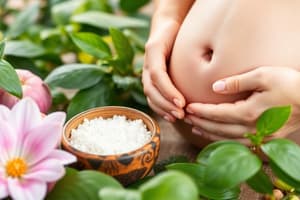Podcast
Questions and Answers
Which forces are known as the 'tridosha' in Ayurveda?
Which forces are known as the 'tridosha' in Ayurveda?
- Iron, Zinc, Copper
- Health, Wealth, Happiness
- Vata, Pitta, Kapha (correct)
- Fire, Water, Air
What skin characteristics are associated with a person having a 'pitta' constitution in Ayurveda?
What skin characteristics are associated with a person having a 'pitta' constitution in Ayurveda?
Fair and red toned skin, prone to sunburns easily.
Curcumin, found in turmeric, has been shown to have antioxidant and anti-inflammatory properties.
Curcumin, found in turmeric, has been shown to have antioxidant and anti-inflammatory properties.
True (A)
Aloe vera is used for healing wounds and burn _______ .
Aloe vera is used for healing wounds and burn _______ .
Match the following Ayurvedic herbs with their application in cosmetics:
Match the following Ayurvedic herbs with their application in cosmetics:
Flashcards are hidden until you start studying
Study Notes
Ayurvedic Cosmetics and Skin Care
Origin of Ayurveda and its Evolution
- Ayurveda is a system of traditional medicine native to India, with a focus on health and wellbeing.
- The principles of Ayurveda are based on healing and healthy living, with the ultimate goal of achieving immortality.
- Ayurveda means "knowledge of life" and has not been fully explored in the Western market, despite its potential benefits.
Ayurvedic Basis for Classification of Skin Types and Tridosha Concept
- The human body is composed of three primal forces: vata, pitta, and kapha.
- These forces are represented individually by:
- Vata: air or energy
- Pitta: fire or chemical activity
- Kapha: earth or material elements
- Based on the dominance of these doshas, individuals can be classified into various skin types: vata, pitta, kapha, or combinations of these.
Skin Types and Characteristics
- Vata Skin: dry, rough, cold, thin, and wrinkled, with a tendency to dehydrate and age prematurely.
- Pitta Skin: delicate, fair, and red-toned, with freckles, moles, or acne, and a tendency to get sunburns easily.
- Kapha Skin: thicker, softer, and oily, with a tendency toward large pores and skin changes due to imbalance.
Skin Disorders and Ayurvedic Treatments
- Eighteen basic types of skin diseases are listed in Ayurveda, including vitiligo, psoriasis, and inflammatory diseases.
- Herbal prescriptions, such as powdered seeds of Psoralea corylifolia, are used to treat skin diseases.
- Other herbs used in Ayurvedic treatments include Ocimum sanctum, Aloe vera, Turmeric, and Sandalwood.
Common Ayurvedic Herbs for Cosmetic Use
- Shikakai: used for cleansing and shampoos.
- Myrrh: used for antimicrobial and antifungal properties in soaps and shampoos.
- Neem: used for antimicrobial and antifungal properties in soaps and oral care.
- Turmeric: used for wound healing and antitumor properties in creams and lotions.
Ayurvedic Herbs and Modern Skin Care
- Curcumin: has anti-inflammatory and antioxidant properties, with therapeutic uses against various pathological conditions.
- Ginger: used for anti-inflammatory and antioxidant properties in creams and lotions.
- Henna: used for hair care and coloring.
- Pomegranate: used for antiaging and wrinkle treatment.
Studying That Suits You
Use AI to generate personalized quizzes and flashcards to suit your learning preferences.




